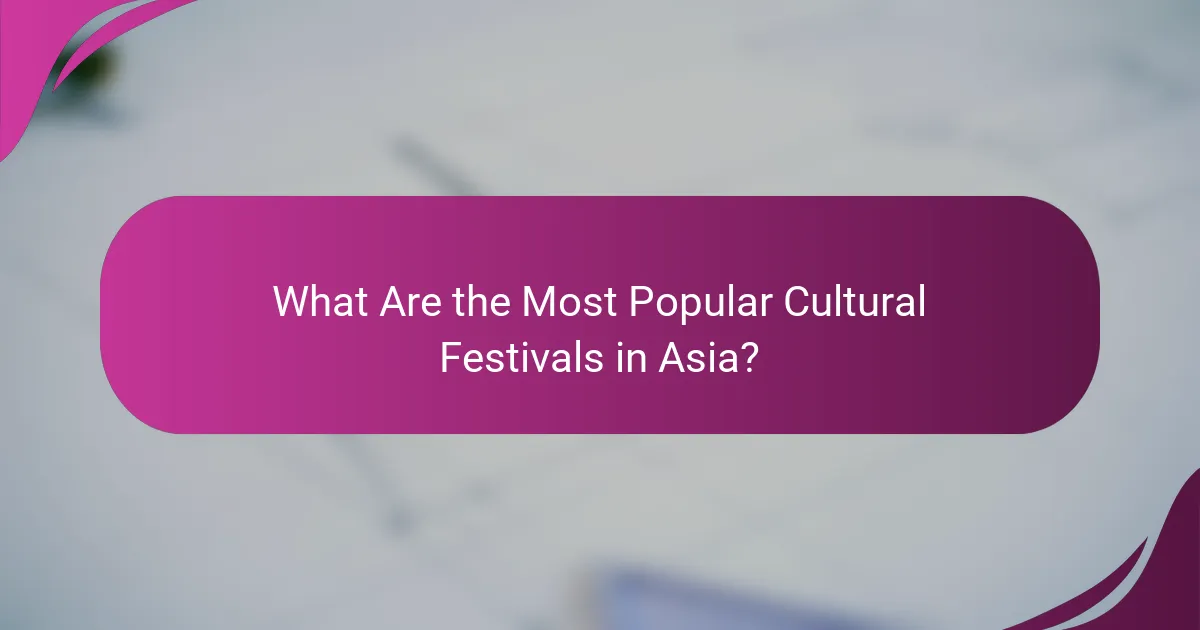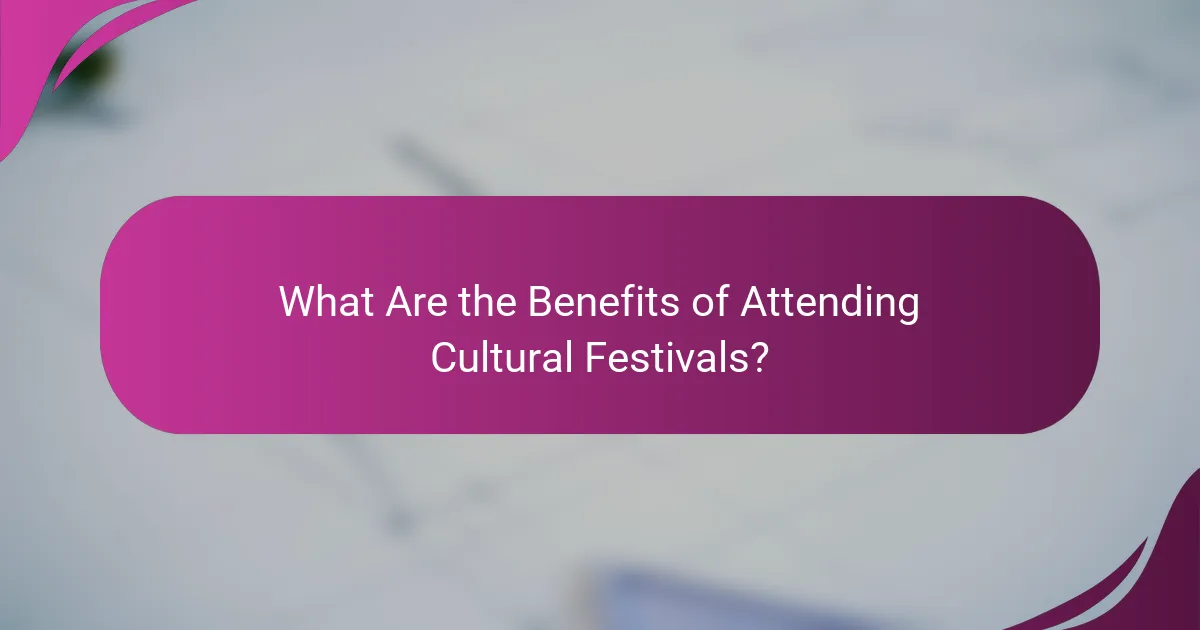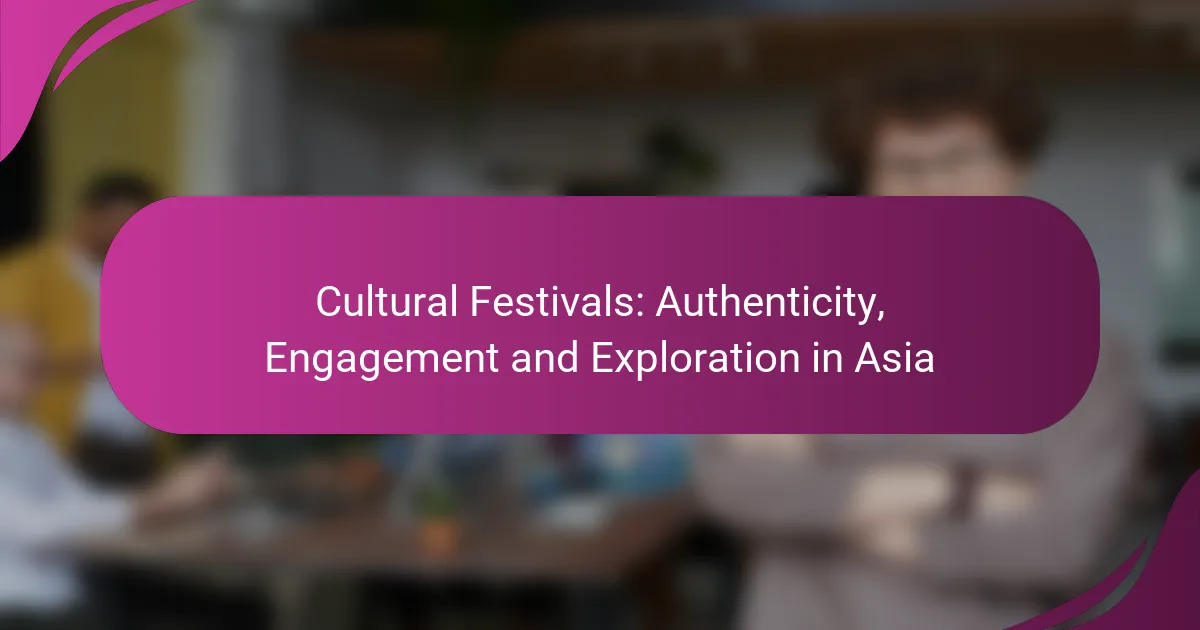Asia is home to a rich tapestry of cultural festivals that provide a unique window into the region’s diverse traditions and heritage. By engaging with local events and exploring regional cuisines, visitors can gain authentic insights and foster meaningful connections with the communities they encounter. Each festival, from Diwali to Songkran, offers distinct experiences that reflect the vibrant spirit of the cultures they celebrate.

How to Experience Authentic Cultural Festivals in Asia?
To experience authentic cultural festivals in Asia, immerse yourself in local traditions, engage with community events, and explore regional cuisine. These activities provide a genuine understanding of the culture and foster connections with local people.
Participate in Local Traditions
Joining local traditions is a key way to experience cultural festivals authentically. This may include participating in rituals, dances, or ceremonies that are central to the festival. For instance, during the Diwali festival in India, lighting lamps and sharing sweets with neighbors can enhance your experience.
Be open to learning and following the customs, as this shows respect and appreciation for the culture. Always ask locals for guidance to ensure you are participating correctly and meaningfully.
Engage with Community Events
Community events often provide a more intimate glimpse into the culture than larger, tourist-focused activities. Look for local parades, performances, or gatherings that are organized by residents. These events typically showcase traditional music, dance, and storytelling, allowing for deeper engagement.
Check local listings or social media platforms for announcements about community events during your visit. Engaging with locals can lead to unexpected experiences and connections.
Explore Regional Cuisine
Food is a vital part of cultural festivals in Asia, offering a taste of local flavors and traditions. Attend food stalls or markets at festivals to sample authentic dishes that are often prepared specifically for the occasion. For example, during the Chinese New Year, dumplings and rice cakes are commonly enjoyed.
Consider joining a cooking class or food tour to learn about the ingredients and techniques used in regional dishes. This not only enhances your culinary knowledge but also deepens your appreciation for the culture.
Attend Workshops and Demonstrations
Workshops and demonstrations during cultural festivals provide hands-on experiences that can enrich your understanding of local arts and crafts. Look for opportunities to try your hand at traditional crafts, such as pottery or weaving, which are often offered at festivals.
Participating in these activities allows you to learn from skilled artisans and gain insight into the cultural significance behind their work. Always check the schedule of events to find workshops that interest you.
Visit Cultural Heritage Sites
Visiting cultural heritage sites during festivals can enhance your experience by providing context and history. Many festivals are held near temples, historical landmarks, or UNESCO World Heritage Sites that reflect the region’s cultural identity.
Plan your festival visit to include time at these sites, as they often host special events or exhibitions related to the festival. This combination of celebration and education can create a more enriching experience.

What Are the Most Popular Cultural Festivals in Asia?
Asia hosts a variety of vibrant cultural festivals that celebrate traditions, heritage, and community spirit. Some of the most popular festivals include Diwali in India, Songkran in Thailand, Chinese New Year, Holi in India, and Gion Matsuri in Japan, each offering unique experiences and cultural insights.
Diwali in India
Diwali, known as the Festival of Lights, is celebrated by millions across India and other countries. It symbolizes the victory of light over darkness and good over evil, marked by lighting oil lamps, decorating homes, and exchanging gifts.
During Diwali, families gather for prayers, feasts, and fireworks. The festival typically lasts five days, with the main day featuring elaborate celebrations and communal activities. Visitors should consider participating in local traditions, such as rangoli making and enjoying festive sweets.
Songkran in Thailand
Songkran, the Thai New Year festival, is famous for its water fights and cultural rituals. Celebrated in mid-April, it marks the transition into the new year and is a time for cleansing and renewal.
During Songkran, locals and tourists alike engage in playful water battles, symbolizing the washing away of sins and bad luck. Temples are visited for prayers, and traditional Thai food is enjoyed. It’s advisable to wear waterproof clothing and protect valuables during the festivities.
Chinese New Year Celebrations
Chinese New Year, also known as Lunar New Year, is one of the most significant festivals in Asia, celebrated by millions worldwide. The festival lasts for about 15 days, with various customs and traditions aimed at bringing good fortune for the year ahead.
Celebrations include family reunions, feasting on traditional foods, and participating in lion dances and fireworks. Each year is associated with a specific animal from the Chinese zodiac, influencing the festivities. Visitors should try traditional dishes like dumplings and rice cakes for a taste of the culture.
Holi Festival in India
Holi, the Festival of Colors, is celebrated primarily in India and marks the arrival of spring. It is a joyous occasion where people throw colored powders and water at each other, symbolizing love and the triumph of good over evil.
This festival encourages community bonding and is often accompanied by music, dance, and festive foods. Holi usually takes place in March, and participants should wear old clothes and be prepared for a fun, messy experience. It’s essential to use natural colors to avoid skin irritation.
Gion Matsuri in Japan
Gion Matsuri is one of Japan’s most famous festivals, held in Kyoto throughout July. It originated in the 9th century as a purification ritual to appease the gods and has evolved into a month-long celebration featuring parades and traditional events.
The highlight is the grand procession of floats on July 17, showcasing intricate designs and craftsmanship. Visitors can enjoy local food stalls and participate in various cultural activities. It’s recommended to check the festival schedule in advance to experience the best events.

How to Choose the Right Cultural Festival to Attend?
Choosing the right cultural festival involves aligning your personal interests with the festival’s offerings, accessibility, and timing. Consider what aspects of culture resonate with you, and ensure the festival is convenient to attend.
Consider Your Interests
Your interests play a crucial role in selecting a cultural festival. If you enjoy music, look for festivals that feature live performances or traditional music. For those passionate about food, culinary festivals showcasing local cuisine may be more appealing.
Additionally, consider whether you prefer immersive experiences, such as workshops and demonstrations, or simply observing performances and exhibitions. Tailoring your choice to your interests enhances your overall experience.
Evaluate Accessibility and Location
Accessibility is key when choosing a cultural festival. Consider the location and how easy it is to reach, whether by public transport or car. Festivals in urban areas may offer better transportation options compared to rural settings.
Also, check for accommodation availability if the festival spans multiple days. Look for nearby hotels or hostels, and consider booking in advance, especially during peak tourist seasons.
Check Festival Dates and Timings
Festival dates and timings can significantly impact your attendance. Verify the schedule to ensure it fits within your travel plans. Many festivals occur annually, so knowing the specific dates can help you plan ahead.
Be aware of any special events or performances that may only happen on certain days. Some festivals may have evening events that cater to different audiences, so check the full schedule to maximize your experience.
Research Cultural Significance
Understanding the cultural significance of a festival can enrich your experience. Research the history and traditions associated with the festival to gain deeper insights into its meaning and purpose.
Look for resources such as official festival websites or local cultural organizations that provide background information. Engaging with the cultural context can enhance your appreciation and connection to the event.

What Are the Benefits of Attending Cultural Festivals?
Attending cultural festivals offers numerous benefits, including enhanced cultural understanding, community engagement, support for local economies, and encouragement of artistic expression. These events provide unique opportunities to immerse oneself in diverse traditions and practices, fostering a deeper appreciation for different cultures.
Enhances Cultural Understanding
Cultural festivals serve as a gateway to understanding the customs, traditions, and values of various communities. By participating in these events, attendees can experience authentic cultural expressions through music, dance, food, and art. This firsthand exposure helps break down stereotypes and fosters mutual respect among different cultures.
For example, festivals like Diwali in India or the Lantern Festival in China allow visitors to engage directly with local practices, promoting a richer understanding of the significance behind these celebrations. Engaging with local artisans and performers can also provide insights into the historical context of these traditions.
Promotes Community Engagement
Cultural festivals are vital for fostering community spirit and collaboration. They bring together individuals from diverse backgrounds, encouraging interaction and dialogue. This engagement can strengthen social ties and create a sense of belonging among participants.
Local organizations often collaborate to organize these events, which can lead to volunteer opportunities and increased civic participation. For instance, festivals in Japan often involve community members in planning and execution, enhancing local pride and cohesion.
Supports Local Economies
Attending cultural festivals can significantly boost local economies by attracting tourists and encouraging spending in the area. Vendors selling food, crafts, and souvenirs benefit from increased foot traffic, while local hotels and restaurants see a rise in business during festival periods.
In many cases, festivals can generate millions in revenue for small towns. For example, the Albuquerque International Balloon Fiesta in the United States draws hundreds of thousands of visitors, providing a substantial economic impact on local businesses.
Encourages Artistic Expression
Cultural festivals provide a platform for artists to showcase their work and creativity. This exposure can lead to new opportunities for artists, helping them gain recognition and support for their craft. Festivals often feature performances, exhibitions, and workshops that highlight local talent.
Moreover, these events can inspire collaboration among artists from different backgrounds, leading to innovative artistic expressions. For instance, the Edinburgh Festival Fringe in Scotland showcases a wide range of performances, from theater to music, encouraging artistic experimentation and diversity.

How to Prepare for a Cultural Festival in Asia?
Preparing for a cultural festival in Asia involves understanding the local customs, planning your itinerary, and ensuring you respect the traditions of the community. Engaging with the festival authentically enhances your experience and fosters positive interactions with locals.
Research Festival Customs
Understanding the customs associated with a specific cultural festival is crucial for meaningful participation. Each festival has unique traditions, rituals, and etiquette that vary widely across different regions in Asia. For instance, during Diwali in India, it is customary to exchange sweets and gifts, while in Japan, the Hanami festival involves picnicking under cherry blossoms.
Start by researching the festival’s history and significance. This can include reading articles, watching documentaries, or connecting with locals through social media platforms. Familiarize yourself with key practices, such as dress codes, food offerings, and any specific behaviors that are considered respectful or disrespectful.
Consider creating a checklist of essential customs to observe. This might include understanding the appropriate greetings, knowing what to bring as gifts, or learning a few key phrases in the local language to enhance your engagement with the community.
